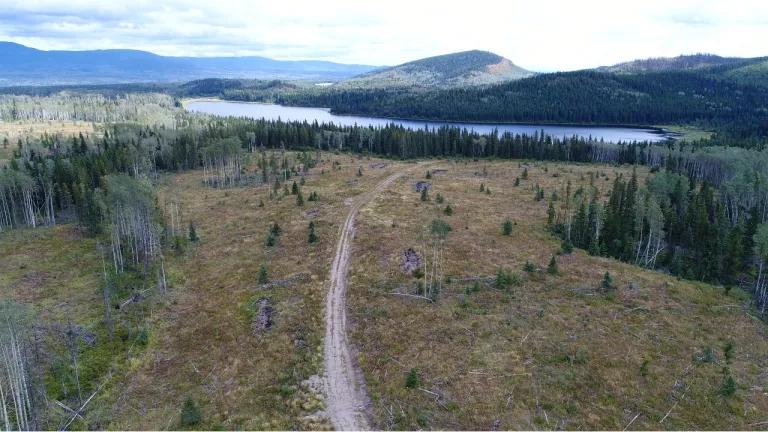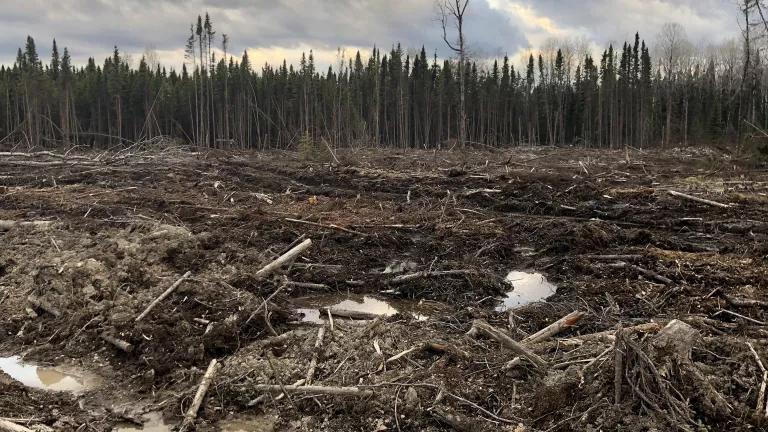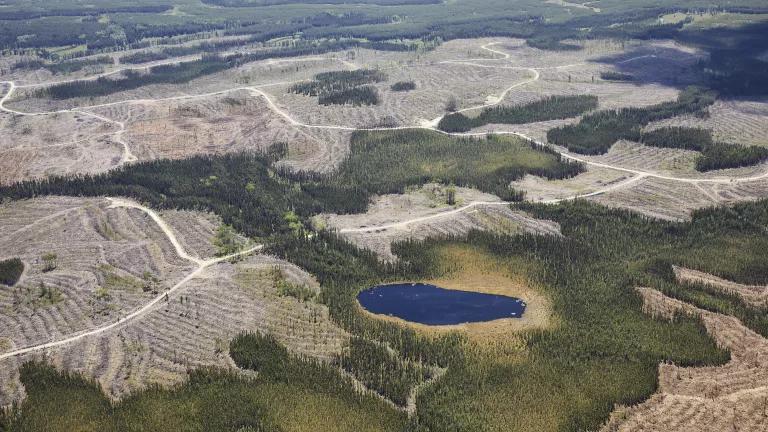Scientists Urge Canada to End Primary Forest Logging
As Canada prepares to release its plan for achieving its climate targets, scientists from around the world have warned that Canada’s logging practices are incompatible with climate leadership and global climate goals.

Clearcut logging in Ontario
River Jordan for NRDC
As Canada prepares to release its plan for achieving its climate targets, scientists from around the world have warned that Canada’s logging practices are incompatible with climate leadership and global climate goals. In a letter to Prime Minister Trudeau, nearly 100 leading scientists from around the world made clear that Canada’s logging of climate-critical primary forests is wildly out of step with the exigencies of the climate crisis. For years, Canada has evaded accountability for its industrial logging practices, hiding behind claims of sustainable forestry and flawed representations of logging’s true climate impact. With our climate future tethered to the fate of primary forests, the scientists warn, Canada’s liquidation of its these vital landscapes would have global, permanent ramifications.
In the letter, 97 world-renowned scientists including Suzanne Simard, Brendan Mackey, Stuart Pimm, and Dominick DellaSala, take aim at Canada’s continued erosion of its primary and older forests and its failure to adopt primary forest protections. These irreplaceable, never-before-logged forests are, as the scientists write, “a critical lifeline to a safe climate,” holding vast stores of carbon and providing habitat for species found nowhere else. As the Intergovernmental Panel on Climate Change (IPCC) has warned, preserving these forests is essential to avoiding catastrophic climate change and to helping the world adapt to locked-in impacts.
Yet Canada continues to log these forests at an alarming rate, with the third-highest intact forest loss globally after Russia and Brazil. Each year, the logging industry in Canada clearcuts more than a million acres in the boreal, the conifer-filled forest that stores twice as much carbon as the world’s oil reserves and nearly twice the carbon per acre as tropical forests. Canada’s logging industry is also eroding the last old-growth forests in British Columbia, leveling canopied forest cathedrals and felling centuries-old giants in minutes.
The climate cost, as the scientists write, is catastrophic, releasing the primary forests’ vast carbon stores and creating a carbon debt that lasts for centuries. Clearcutting also leaves the landscape even more vulnerable to climate change as the forests that regrow are typically far less resilient in the face of wildfires and other growing climate impacts. Trees, for all their reputation as a “renewable resource,” aren’t interchangeable parts. Trees can be replanted; primary forests can’t.
While the Trudeau government has made commitments to natural climate solutions, Canada has no meaningful protections for these vital primary forests. In fact, Canada has even aggressively opposed proposed legislation in California and New York that would address the states’ sourcing from primary boreal forests. In its opposition, Canada touted the sustainability of its practices. While Canadian officials acknowledged the importance of protecting primary forests in the tropics, it questioned the necessity of similar restrictions in the Global North.
As the letter makes clear, however, there’s no such thing as sustainable sourcing from a primary forest—and certainly not one as carbon-rich as the Canadian boreal. To fill this policy gap, the scientists “strongly encourage Canada to adopt policies that will incentivize protection of primary and older forests, particularly under the leadership of Indigenous Peoples and in accordance with Indigenous Peoples’ internationally recognized rights.”

Clearcut logging in Quebec
The letter also calls on Canada to review and reform its forest carbon accounting practices amid growing concerns that Canada’s reported logging emissions significantly underrepresent the industry’s true climate cost. As a recent report from NRDC and Canadian partners found, through a number of accounting flaws, loopholes, and artifices, Canada is downplaying the logging industry’s annual carbon footprint by more than 100 megatons of carbon dioxide, or more than 10% of Canada’s other total emissions.
In pushing these emissions off the books, Canada artificially portrays its logging sector as carbon-neutral, allowing the industry to escape scrutiny for its significant climate impact. This obfuscation has reverberations across Canadian policy, underrepresenting the importance of primary forest protection, warping decision making, and undermining the government’s natural climate solutions commitments.
The scientists’ letter is just the latest of growing calls from international scientists to protect primary and older forests to avoid climate catastrophe and biodiversity collapse. The IPCC has made clear that these forests are critical to both climate mitigation and adaptation and urged transformations to global forest policy and forest product supply chains.
The international community has also increasingly recognized that forests are central to global climate ambition. Last fall, over 140 countries, including Canada, signed onto the Glasgow Leaders’ Declaration on Forests and Land Use, pledging to eliminate deforestation and land degradation by 2030. Ultimately, the success of this agreement will depend on countries, particularly in the Global North, reckoning with their own unsustainable practices and ensuring the protection of their primary and older forests.
Primary forest protections aren’t just an environmental exigency, but also a marketplace necessity. Companies and investors have recognized the environmental and reputational risks inherent in continuing to source from primary forests and have taken measures to end their entanglement with these unsustainable supply chains. Consumers are increasingly unwilling to pay the high price of our forests for products like throwaway toilet paper. If Canada is going to remain competitive in an increasingly forest- and climate-conscious marketplace, it can’t remain mired in antiquated and dangerous logging practices.
Canada has the opportunity to lead the way toward a global framework that ensures the protection of climate critical forests from the tropics to the boreal. Canada can help shape a more sustainable forest economy founded on climate imperatives and Indigenous justice, prioritizing the protection of primary forests under the leadership of Indigenous Peoples. However, this depends on Canada breaking free of industry spin and embracing a policy vision founded on scientific reality: that the world can no longer afford Canada’s dangerous and short-sighted erosion of its primary forests.



